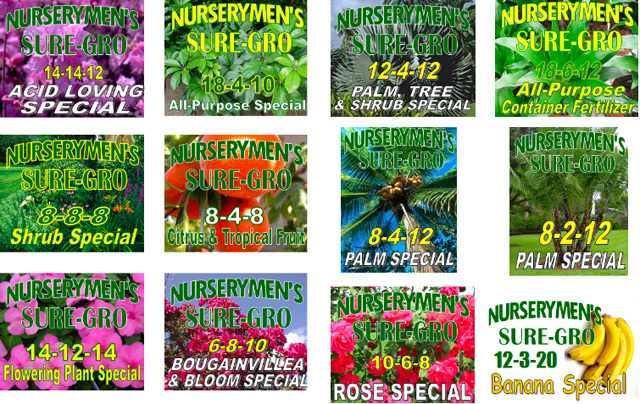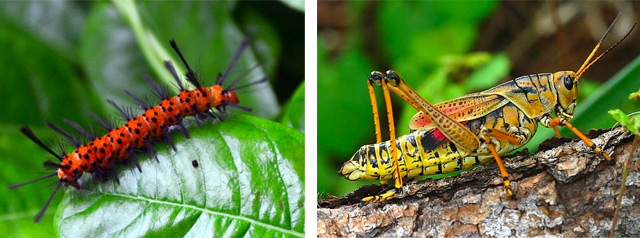
Fertilize:
If you haven’t fertilized your landscape shrubs, trees and palms since spring- do so now! The stress of summer and frequent rains has depleted the nutrients in the soil and your plants need food! Non flowering trees and shrubs can be fertilized with 8-4-12 slow release granular. For flowering shrubs, trees and perennials use 6-8-10 slow release for blooming. If you didn’t fertilize your palms in July then do so now with Nurserymen SureGro 8-4-12 Palm Fertilizer slow release granules.
VerdeGo also carries Nurserymen SureGro 12-4-12 for those customers who reside in coastal areas. This product can be used on your shrubbery, trees and palms in areas with high salt and shell concentrations in the soil. For blooming plants use the Nurserymen 6-8-12 Bloomer.
Lastly, orchids require fertilization every 2-3 weeks during the warm months because the plants are actively growing right now.
Trimming:
Now that summer rains have come, monitor your plants as they can grow like crazy! Keep ahead of the game by pruning. Too often gardeners are afraid to trim but if your pentas, bush daisies, lantanas or any other plant or perennial have become overgrown and leggy- trim them back and fertilize and the results will make you a believer in pruning!
Continue to trim your hedges, however, allow new shoots to grow 5-6 inches before shearing. Remember, in order to create density, plants should be trimmed lightly all over, not just on the top!
Trim old seed heads from crape myrtles (if you can reach) to encourage more flowers; prune roses if needed and continue to deadhead your annuals and perennials.
Pruning time is over for azaleas, camellias and gardenias and August is the last pruning time for bougainvillea and poinsettias.
Pests & Disease:
Insects are very active now. Aphids and chili thrips will suck the life right out of your plants, causing them to thin out, have yellowing and spotted leaves and leaf tips and buds will look small and shriveled. Spinosad is an excellent natural product for Thrips as well as Horticultural Oils for aphids however, remember the 7-7 Rule when applying sprays. 7 in the morning or 7 in the evening to prevent burn damage.
Watch for black spot on Roses or other foliage plants. Control by watering in the morning to allow foliage to dry completely in the sun. As rains are abundant right now, you may not need to run your irrigation system at all to minimize fungal disease.
Monitor your lawns for Brown Patch- a turf disease caused by fungus in the soil. The disease causes large brown, somewhat circular areas to develop. Control the amount of water if possible and treat with a fungicide if necessary.
Also watch for signs of chinch bugs in St. Augustine grass, evident by yellowish to brown patches along sidewalks, driveways or other water stressed areas in the full sun. If the product you are currently using does not control the bugs, you may have a resistant type and switching and alternating products may help.
Bahia customers should be on the lookout for mole crickets as they are making reappearance. Your turf will feel soft and spongy.
Powdery mildew is a common disease of many landscape plants that appears as a white covering on the surface of the foliage and buds. Overcrowding with poor air circulation is often a culprit along with overwatering. Solve the cultural problems first and treat with fungicides that will help with the spread.

Something chewing your plants??
Oleander Caterpillars should be making an appearance now if they haven’t already done so. A female moth lays her eggs on the underside of the leaves and when the larvae hatch they will begin to consume the underside of the leaf first-which makes them difficult to spot. As they continue to grow they will eventually consume the entire leaf at an enormously fast rate! A plant can be defoliated practically overnight. It is good practice to check your oleanders frequently this time of the year to determine presence. If you have these “critters” you can spray them Horticultural Oils. There is also a systemic insecticide which will help keep the caterpillars from eating the plant. These caterpillars are not necessarily strictly for oleanders either- if you have Mandevillea, Dipladenia or Desert Rose- also be vigilant.
Eastern Lubber Grasshoppers are also around this time of year. The eggs are generally laid in early spring and the nymphs appear around March in our part of Florida. The nymphs are virtually black and congregate in great numbers. They “roost” in plants in the night time. When these grasshoppers are at this stage they can be controlled by insecticides. Unfortunately, as they continue to grow to the large adult size, it is difficult to kill them with an insecticide. This is where “two bricks” come in! The adult Lubber will chew its way through a plant overnight. Some common plants that get attacked are those with large strap like leaves such as Crinum Lilies or Canna Lilies. If you encounter one, the good news is they don’t move too fast and can’t fly so you generally should be able to get it. Again, be vigilant – the first sign of large chomp bites out of your plant can often mean these “prehistoric” looking grasshoppers.
If you have any of these problems or any other problems, stop by the Garden Center for advice or email: landscape@verdego.com . We would be happy to help!